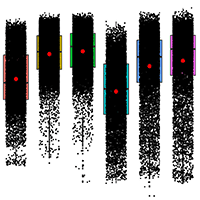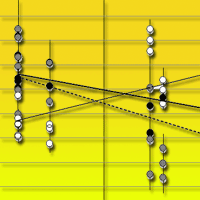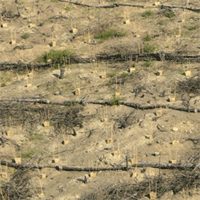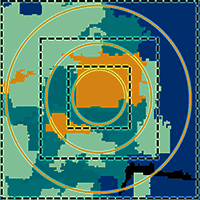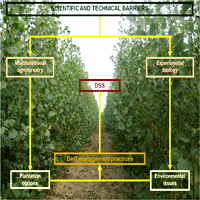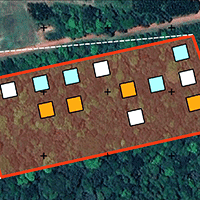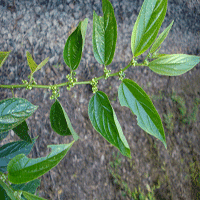
Woody species recruitment under monospecific plantations of pioneer trees - facilitation or inhibition?
DFV Trindade (1), GC Coelho (2)
iForest - Biogeosciences and Forestry, Volume 5, Issue 1, Pages 1-5 (2012)
doi: https://doi.org/10.3832/ifor0601-009
Published: Feb 06, 2012 - Copyright © 2012 SISEF
Research Articles
Abstract
The successional model of forest restoration is based on the facilitation process, in which the establishment of pioneer tree species favors the late successional tree species. We tested the hypothesis of facilitation through a case study, comparing tree species diversity in the understory of two Neotropical native tree species plantations, Trema micrantha (L.) Blüme (Cannabaceae) and Schinus molle L. (Anacardiaceae). Results obtained under the plantations were compared with an adjacent area under spontaneous secondary succession, analyzing the ligneous plant diversity, soil physic-chemistry and shading. Additionally, the seed rain under the two plantations was analyzed. The area of spontaneous secondary succession and the area with T. micrantha had the highest ligneous plant diversity. The understory of T. micrantha plantation had the lowest light intensity and higher late successional species abundance. In addition, T. micrantha had higher plant diversity than S. molle, which could be explained at least partially by higher diversity in the seed rain. Higher litterfall and mineral content of leaves and twigs of T. micrantha did not coincide with higher topsoil mineral content under that species. Instead, soil under S. molle had higher level of P than the soil under T. micrantha. Data suggest that a high diversity of ligneous plants could be thrived by the spontaneous succession. On the other hand, T. micrantha had promoted a higher richness and abundance of late successional species, which could be related to a more pronounced shade effect, in agreement with the facilitation conception. The lowest diversity and density of ligneous plant species under S. molle characterizes an inhibition effect. T. micrantha could be included in restoration plans assembled with other species or combined with areas without intervention, whenever the spontaneous regeneration is possible.
Keywords
Forest restoration, Secondary succession, Shading, Solanum mauriatianum, Schinus terebinthifolius
Authors’ Info
Authors’ address
UNIJUÍ, Rua do Comércio 3000, Universitário, 98700 000, Ijuí, Rio Grande do Sul (Brazil)
Universidade Federal da Fronteira Sul, Av. Presidente Getúlio Vargas 609-N, 2° andar, Centro, 89812-000, Chapecó, Santa Catarina (Brazil)
Corresponding author
Paper Info
Citation
Trindade DFV, Coelho GC (2012). Woody species recruitment under monospecific plantations of pioneer trees - facilitation or inhibition?. iForest 5: 1-5. - doi: 10.3832/ifor0601-009
Academic Editor
Roberto Tognetti
Paper history
Received: Sep 01, 2011
Accepted: Nov 28, 2011
First online: Feb 06, 2012
Publication Date: Feb 27, 2012
Publication Time: 2.33 months
Copyright Information
© SISEF - The Italian Society of Silviculture and Forest Ecology 2012
Open Access
This article is distributed under the terms of the Creative Commons Attribution-Non Commercial 4.0 International (https://creativecommons.org/licenses/by-nc/4.0/), which permits unrestricted use, distribution, and reproduction in any medium, provided you give appropriate credit to the original author(s) and the source, provide a link to the Creative Commons license, and indicate if changes were made.
Web Metrics
Breakdown by View Type
Article Usage
Total Article Views: 56188
(from publication date up to now)
Breakdown by View Type
HTML Page Views: 47476
Abstract Page Views: 3239
PDF Downloads: 4070
Citation/Reference Downloads: 20
XML Downloads: 1383
Web Metrics
Days since publication: 5046
Overall contacts: 56188
Avg. contacts per week: 77.95
Citation Metrics
Article Citations
Article citations are based on data periodically collected from the Clarivate Web of Science web site
(last update: Mar 2025)
Total number of cites (since 2012): 7
Average cites per year: 0.50
Publication Metrics
by Dimensions ©
Articles citing this article
List of the papers citing this article based on CrossRef Cited-by.
References
Field and laboratory methods for general ecology (4 edn). McGraw-Hill, EUA, pp. 273.
Gscholar
Introducción. In: “La Selva Misionera - opciones para su conservación y uso sustentable” (Burkart R, Cinto JP, Chébez JC, Fernández JG, Riegelhaupt E eds). FUCEMA, Buenos Aires, Argentina, pp. 11-16.
Gscholar
Espécies florestais brasileiras: recomendações silviculturais, potencialidades e uso da madeira. EMBRAPA-CNPF, Brasília, Brazil.
Gscholar
Restauração florestal em pequenas propriedades: desafios e oportunidades. In: “Gestão ambiental nos municípios: instrumentos e experiências na administração pública” (Hüller A ed). FURI, Santo Angelo, Brazil, pp. 195-215.
Gscholar
Recuperação de solos degradados. In: “Restauração ecológica de ecossistemas naturais” (Kageyama PY, Oliveira RE, Moraes LFD, Engel VL, Gandara FB eds). FEPAF, Botucatu, Brazil, pp. 111-163.
Gscholar
Implantação de matas ciliares: estratégia para auxiliar a sucessão secundária. In: “Simpósio sobre mata ciliar” (Barbosa LM ed). Fundação Cargill, Campinas, Brazil, pp. 130-143.
Gscholar
Recuperação de áreas ciliares. In: “Mata ciliares: uma abordagem multidisciplinar” (Rodrigues RR, Leitão Filho HF eds). EDUSP/FAPESP, São Paulo, Brazil, pp. 249-269.
Gscholar
Amazonian forest restoration: an innovative system for native species selection based on phenological data and field performance indices. Commonwealth Forestry Review 74: 230-243.
Gscholar
Análise da diversidade florística e dos sistemas de dispersão de sementes em um fragmento florestal na região central do Rio Grande do Sul, Brasil. Napaea 12: 49-67.
Gscholar
Dry artificial perches and the seed rain in a subtropical riparian forest. Revista Brasileira de Biociências 7: 246-252.
Gscholar
Restoration of damaged land areas: using nucleation to improve successional processes. Natureza & Conservação 1: 85-92.
Gscholar
Performance of 45 native tree species on degraded lands in Singapore. Journal of Tropical Forest Science 19: 25-34.
Gscholar
Análise de solo, plantas e outros materiais. Boletim técnico no. 5, Departamento de Solos/UFRGS, Porto Alegre, Brazil.
Gscholar
Seed dispersal by birds on artificial perches in reclaimed areas after surface coal mining in Siderópolis municipality, Santa Catarina State, Brazil. Revista Brasileira de Biociências 8: 14-23.
Gscholar



